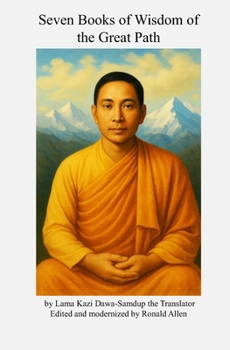Seven Books of Wisdom of the Great Path
This book presents a rare and systematic journey through the depths of Mahāyāna Buddhism, guiding readers from the precepts of discipleship to the realization of emptiness and wisdom. Drawing from Tibetan sources, meditative manuals, and commentaries, it is arranged into seven books that combine ethics, yogic practice, symbolism, and philosophy.
Book I: The Supreme Path of Discipleship lays the foundation through the Twenty-Eight Categories of Yogic Precepts. These teachings clarify what to practice, avoid, and persevere in, while warning against errors and false appearances. They cultivate clarity, perseverance, and sincerity, forming the ground of discipline for higher realization.
Book II: The Nirvāṇic Path-The Yoga of the Great Symbol turns to meditation. Beginning with posture, speech, and mental calm, it progresses through practices that still discursive thought, reveal the uncreated nature of consciousness, and stabilize insight into the timeless present. This culminates in the recognition of Mahāmudrā, where mind shows its luminous essence.
Book III: The Path of Knowledge-The Yoga of the Six Doctrines presents inner yogas: psychic heat, illusory body, dream, clear light, bardo, and consciousness transference. Each is explained in relation to Mahāyāna thought, showing their purpose as deepening insight into impermanence, illusion, and innate radiance.
Book IV: The Path of Transference focuses further on consciousness-transference, especially at death. Rooted in devotion and visualization of enlightened beings, these practices reveal awareness beyond physical life. For advanced practitioners, they enable fearless transition; for others, they offer confidence and reliance on compassionate guidance.
Book V: The Path of the Mystic Sacrifice confronts ego and its obstacles. Through symbolic dance, visualization, and offering, the practitioner dedicates even the "illusory body" to wisdom. This sacrifice is not worldly loss but transformation of self-clinging into compassion, embodying the Bodhisattva ideal of selfless dedication.
Book VI: The Path of the Five Wisdoms-The Yoga of the Long HŪṂ examines the sacred syllable HŪṂ, divided into five elements linked with the Dhyāni Buddhas and their Five Wisdoms: Dharma-Dhātu, Mirror-like, Equality, Discriminating, and All-Perfecting. Through meditation, the five poisons of ignorance, anger, pride, desire, and envy are transmuted into wisdom. Here, sound and realization converge into direct transformation.
Book VII: The Path of the Transcendental Wisdom-The Yoga of the Voidness returns to the Praj ā-Pāramitā. Drawing from the Diamond Sūtra, Nāgārjuna, and Tibetan sources, it shows emptiness as both philosophy and practice. Phenomena are seen as empty, yet emptiness itself is radiant with potential. The Bodhisattva, nourished by Praj ā-Pāramitā-the Mother of Buddhas-realizes nirvāṇa is not apart from saṃsāra, and that wisdom must serve the liberation of all beings.
Across these seven books, the reader is led step by step: from ethics to meditation, from yogic methods to philosophical insight, from symbolic practice to the supreme understanding of voidness. Each teaching is offered not as abstract doctrine but as a guide for practice. Closing reflections echo the Praj ā-Pāramitā Sūtra: this fleeting world is like a dream, a lightning flash, a bubble in a stream.
Ultimately, this work is both exposition and map of the Bodhisattva's path. It unites discipline, meditation, wisdom, and compassion into a coherent vision of liberation. For students of Mahāyāna Buddhism, it offers both breadth and depth: a survey of doctrine and practice, and a guide to transforming the mind.





